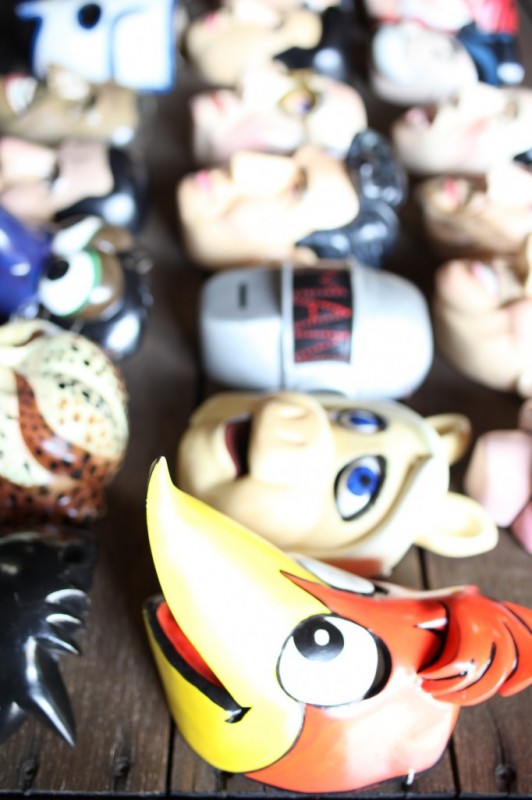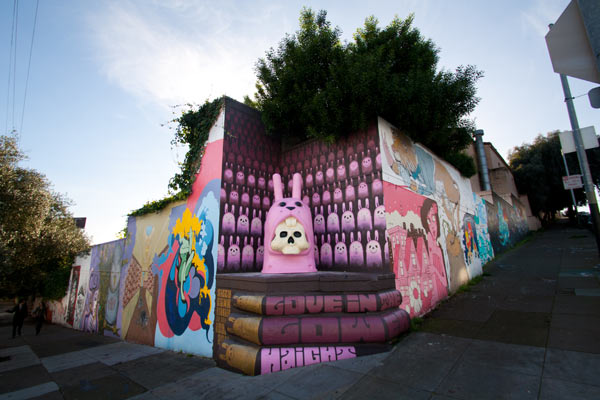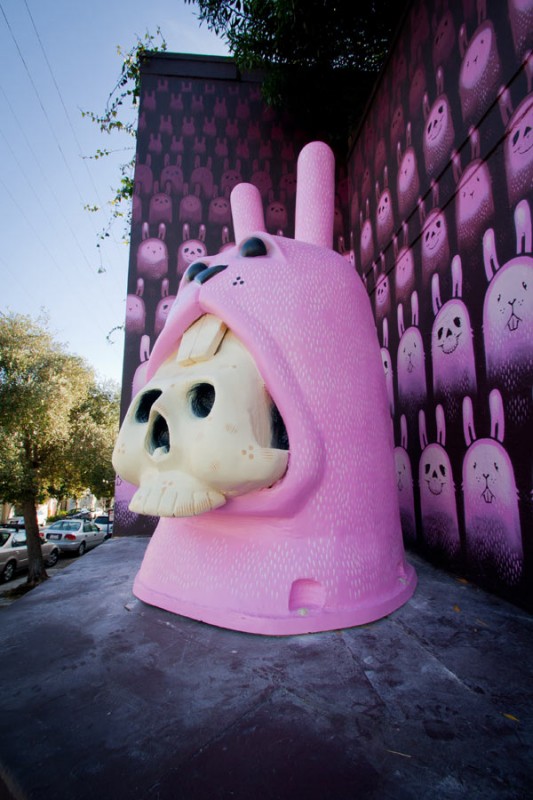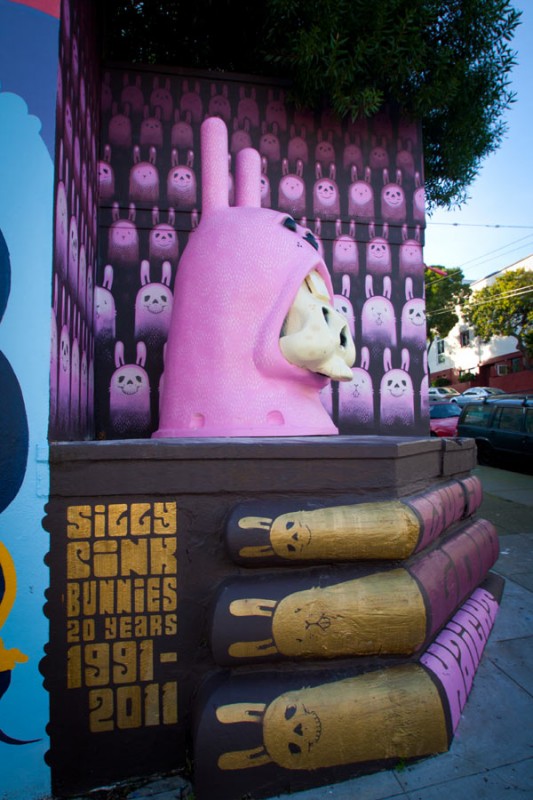INSA Opens Tonight
Just a friendly reminder that we are opening a new exhibition in San Francisco tonight, for London-based artist INSA. That gif up there? That is a special piece for this show. You saw some of the murals, so come see much MORE tonight. FIFTY24SF Gallery in Association with Upper Playground presents: “MORE” – A collection of new work by INSA SAN FRANCISCO, CA [1.28.11] – Upper Playground and FIFTY24SF Gallery are pleased to announce London-based graffiti, conceptual, and fine artist INSA’s first solo exhibition in San Francisco opening on February 3rd, 2011. The exhibition is appropriately titled, MORE. Within the new body of work in MORE, INSA explores themes of aspiration and expectation, wants versus needs, and happiness versus success in his most comprehensive study to date. Using exaggerated symbols of sexuality representing the commodification of both everyday life and underground subcultures, INSA examines the illusions of seduction while employing his own iconic brand of aesthetic allure to draw the audience in. INSA’s new work revels in lurid excess, embracing the insatiability of consumerism and highlighting the duplicity of morality and enjoyment. Followers of the artist will be familiar with some of the themes displayed in MORE. INSA, constantly involved in interesting new projects, recently gained worldwide attention for his piece “Anything Goes When It Comes To (S)hoes,” (more commonly referred to as his “Elephant Dung Heels”) which were exhibited at Tate Britain in London. He has also been a pioneer in the world of graffiti on the Internet with his visually stunning, labor intensive “Gifitti.” This is all in addition to INSA”s continuing insatiable need to cover any surface with his signature “Graffiti Fetish” pattern. MORE will feature 9 new provocative works, with INSA utilizing media such as sculpture and lights adding to the “glamour” of his work. The exhibition will also feature an exclusive SF edition of INSA’s classic “Heel” print and a selection of photographic prints. MORE will run at FIFTY24SF Gallery from February 3rd, 2011 – February 28th, 2011
PEZ’S “LOUDER THAN BOMBS” FOR NOISE POP X FIFTY24SF EXHIBITION OPENS TONIGHT
Noise Pop x FIFTY24sf present PEZ “Louder Than Bombs”. The title “Louder Than Bombs” is in direct reference to The Smiths compilation album released in 1987, the band, and Morrissey, being a personal favorite of the artist. As a long time Bay Area staple PEZ’s hand style and graffiti has been seen most places you’ve looked—but his record covers and limited edition zines have reached cult status over the last few years and this exhibition reveals what makes the underground music, art and culture of the Bay Area so special.
About the Artist: PEZ is widely recognized around the world as one of the earliest sticker taggers in the history of graffiti, following in the footsteps of the legendary and infamous graffiti artists, Cost and Revs. He documented his experiences in with his Nikon FM2 35mm camera, and continued to post his stickers and other printed work around NYC. Today, Pez continues to make stickers and publish photography zines. Pez has exhibited in New York City, San Francisco, Los Angeles, Portland, and Tokyo.
INSA's "MORE" opens Feb 3rd at FIFTY24SF
FIFTY24SF Gallery in Association with Upper Playground presents: "MORE" - A collection of new work by INSA
SAN FRANCISCO, CA [1.28.11] -- Upper Playground and FIFTY24SF Gallery are pleased to announce London-based graffiti, conceptual, and fine artist INSA’s first solo exhibition in San Francisco opening on February 3rd, 2011. The exhibition is appropriately titled, MORE.
Within the new body of work in MORE, INSA explores themes of aspiration and expectation, wants versus needs, and happiness versus success in his most comprehensive study to date. Using exaggerated symbols of sexuality representing the commodification of both everyday life and underground subcultures, INSA examines the illusions of seduction while employing his own iconic brand of aesthetic allure to draw the audience in. INSA’s new work revels in lurid excess, embracing the insatiability of consumerism and highlighting the duplicity of morality and enjoyment.
Followers of the artist will be familiar with some of the themes displayed in MORE. INSA, constantly involved in interesting new projects, recently gained worldwide attention for his piece “Anything Goes When It Comes To (S)hoes,” (more commonly referred to as his “Elephant Dung Heels”) which were exhibited at Tate Britain in London. He has also been a pioneer in the world of graffiti on the Internet with his visually stunning, labor intensive “Gifitti.” This is all in addition to INSA”s continuing insatiable need to cover any surface with his signature “Graffiti Fetish” pattern.
MORE will feature 9 new provocative works, with INSA utilizing media such as sculpture and lights adding to the “glamour” of his work. The exhibition will also feature an exclusive SF edition of INSA’s classic “Heel” print and a selection of photographic prints.
MORE will run at FIFTY24SF Gallery from February 3rd, 2011 - February 28th, 2011
INSA Painting on Scott and Oak in SF
INSA for LA Freewalls Project-
Before heading back up to San Francisco INSA painted a 70 foot wall in downtown L.A. His request was for the dirtiest wall in L.A. so they gave him The Play Pen . . .
Read the rest at Jet-Set Graffiti
Jeremy Fish Statue in the Lower Haight
Jeremy Fish just put the finishing touches on his mural at the entryway to the Lower Haight mural. The mural includes the work from Ericailcane, Doze Green, Mars-1, and David Choong Lee. And now, you will see a Silly Pink Bunny sculpture.
Photos by Aaron Durand.
Noise Pop x FIFTY24SF Present "Louder Than Bombs" Album covers by PEZ
Opening Feb. 2nd at the Noise Pop Up Gallery
Rico Deniro Mask Photos
Rico Deniro at FIFTY24SF
Rico Deniro’s month long ‘Native Expatriots’ show at FIFTY24SF Gallery will be opening tomorrow (Saturday) at noon. For the show, Rico has presented people that live outside of technologically based civilizations in the rural villages of Mexico with images of first-world pop culture icons and employed them with one task: to interpret those icons in a traditional Mexican wooden mask. The craftsmen of these masks have no reference point to these images, no sense of importance tied to the celebrities that they were given, no inundation of cultural significance by media sources – and instead translate the images into form at a completely superficial and innocent level.
The resulting masks show these idols at a level which we rarely see them: exposed. Not in the way that the news media ‘exposes’ celebrities, because in that case there’s a symbiotic dependency – but in the way that these idols are exposed for their lack of substance other than the media and marketing that convinces us of their substance.
The masks created in Mexico will be on display at FIFTY24SF Gallery at 218 Fillmore Street, San Francisco from January 6th, 2011 – January 26th, 2011.
(Photo taken by Estevan Oriol)
INSA is coming
INSA just arrived in the U.S. but is heading down to L.A. to this week to do some painting before he returns to S.F. for his February show.
Past Exhibiting Artist El Mac's Singapore Video
El Mac Singapore from Viet Nam The World Tour on Vimeo.
JEREMY FISH INTERPRETED BY RICO DENIRO SHOT BY ESTEVAN ORIOL
Opens Saturday, January 8th, 2011 at FIFTY24SF Gallery
Herbert Baglione at Lazarides - Found Super 8 Footage
Watch the super 8 footage of Herbert Baglione working on a wall at Lazarides Gallery.
Herbert Baglione - Lazarides Gallery from Upper Playground on Vimeo.
FIFTY24SF 2011 Gallery Lineup: Rico Deniro, INSA, KMNDZ, Escif, San, and Stussy/Stecyk/Adler
We are getting excited for 2011.
January: Rico Deniro
February: INSA
March: Shawn Stussy/C.R. Stecyk/ Thomas Adler group curated show
April-May: KMNDZ

June- July: Escif and SAN


Rico Deniro at FIFTY24 SF: January 2011
Artist Rico Deniro is the first gallery show at FIFTY24SF in San Francisco for us in 2011. The exhibition, Native Expatriots, is the first solo showing of Deniro’s wood-masks, handmade with master woodworkers in Mexico. More details to come. Photos by Estevan Oriol.

Art of the Anonymous

Photographs from unknown photographers have lined the walls of museums, been sold off at fine-art auctions for thousands and can be found collecting dust / old sunlight in alleys behind houses or in between the pages of a used book.
The appeal of a found-photograph is virtually universal- it appeals to the mysterious parts of our psyche, the voyeuristic and the imaginative. The snapshot aesthetic popularized by MoMA director of photography John Szarkowski and photographers Eggleston, Parr, Freidlander, Arbus and Winogrand in the mid-sixties relates immediately to these images for they are themselves “snapshots.” The main difference being that with found images, an artist’s name is stripped from the work- there is no resume / reputation for the image to fall on.
These images, then, are just that – images – taken by anonymous persons from the dawn of photography to its current state.
The first found-photograph I came across was in the pages of an Edna St. Vincent Millay book that I’d found in the street in San Francisco. The image was of a woman’s face staring directly into the camera of a photo-booth. Long an admirer of Millay, I soon found myself associating her work with this face- a photograph I imagine a woman or man used as a placeholder or bookmark. I remember inventing stories for that image, sifting through junk at several stores in order to find more images, more photographs.
Recently, whilst sifting through the detritus of a junk shop, I came across a photo-album several inches thick which chronicled in images the immigration of several generations of a family’s journey from Mexico into the United States. The pages begin in the ’40s, prints from the recently released “square-brownie” Kodak camera filling up the space in black and white; on other pages scattered collages of cyanotypes, photo-booth images caked in chemicals and small thin rectangular prints popularized at the time in the albumen process of different shades of brown and black. As each page is turned, the history not only of the family, but of photography is revealed casually, nonchalantly. The pages go from black and white to color- small square prints changing over the years to the now common 5 X 7 print taken on a point-and-shoot camera. Several scattered studio “star-shots” popular in the mid-nineties amongst adolescents and images printed on computer paper cut out and glued haphazardly occupy the last remaining pages of the album as an addendum- those images being the ones that have most deteriorated.
With digital photography proliferating rapidly- cameras miniature enough that they fit into pockets, cameras on phones and options obliterated / streamlined to the point where even a child can operate them- it makes one wonder what artifacts / documents will be left for one to find – if any – from this age or the future and in what form they will be.
The tangibility of a memory is what I used to characterize a photograph as. Now, it seems that the alleys of the future are those of the internet- abandoned web-sites or blogs that catalogue found images.
Here is a collection of the many-thousand photographs that I have acquired and accrued through my hoarding, collecting and archiving of strangers’ items.
- Jason Jaworski San Francisco, CA 2010
Kenta Torri at FIFTY24MX Gallery
Mexico City-based but Japanese born Kenta Torri is showing at FIFTY24MX Gallery with a solo show called Saiyuki Punk. The show inspired by the ancient Chinese story “Journey to the West” (the same that inspired Dragon Ball) in which the main character, the Monkey King, travels to the west to rescue some manuscripts. In this journey the characters fight in spiritual battles to reach illumination. Kenta reinterprets the story mixing traditional iconography with a contemporary punk aesthetics.
FIFTY24MX presents MiniMart and a new mural by Ericailcane
FIFTY24MX has curated an awesome collective show with original artwork and limited edition prints from more than 20 international and local artists – including Alex Pardee, Charles Glaubitz, Sam Flores, Rene Almanza, Saner and many more. The show opened last weekend and will be open until Sunday 19th Dec.
The location is a beautiful art noveau mansion in la Roma district, the young, bursting neighborhood of DF . Current FIFTY24SF artist, Ericailcane, made an amazing mural in the entrance and during the week there’s been several events: art documentaries projections, music concerts, multimedia art and lots of parties, tequila and wine. Tons of images of the work below, but to check the entire show, images and the catalogue. CLICK TO SEE THE REST
More Photo's from Herbert Baglione's "Ashes of our Time"
Other artists in this group show at Winterlong Gallerie in Niort, France include Guillaume Antzenberger, Samuel François, Renaud Combes.



















































